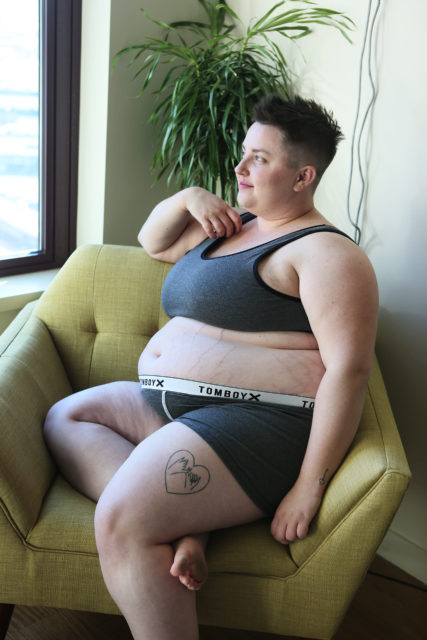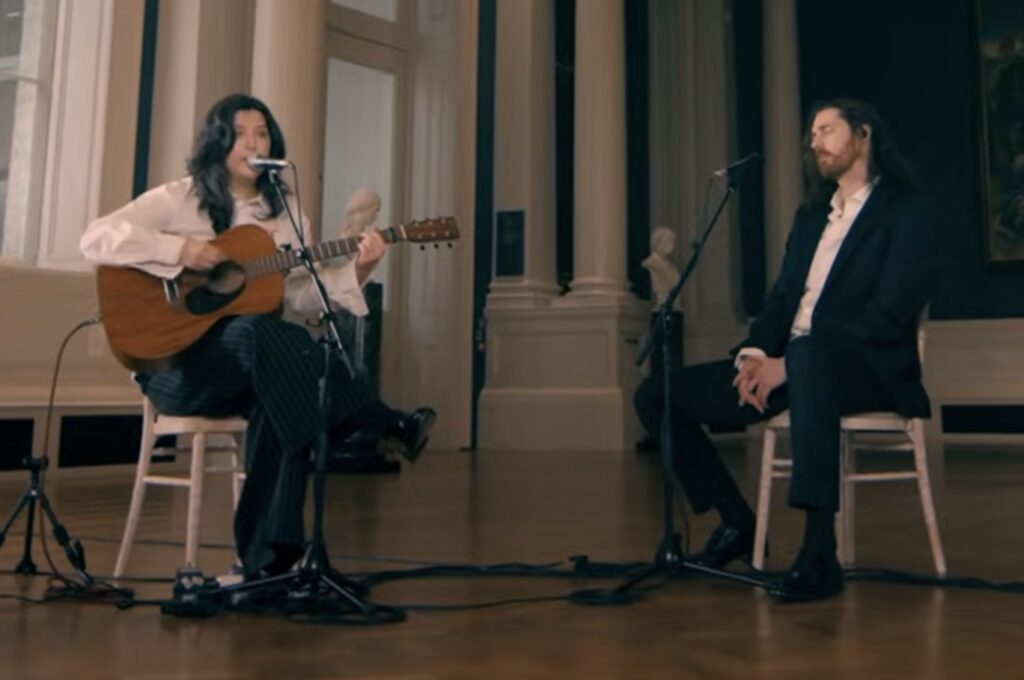Lesbian Fashion Chronicles: How To Find Butch Plus Size Clothing

Plus-size butch fashion is the future.

If you’re into style, there’s a good chance you probably noticed the rise in gender-neutral and queer fashion. Earlier this year, fall non-binary looks from the Krammer & Stoudt show prompted this eye-catching New York Times headline, “Opening New York Men’s Fashion Week: A Show With No Men.” While it’s true that we are seeing a trickle down of queer fashion into the mainstream, it remains a fierce challenge for plus size butch folks to find masculine-of-center clothing.
I love me a fine blazer, yet something was always getting in the way – my hips. Tops would easily fit my shoulders but then splay out around me like a crop top gone terribly wrong. Shopping for clothes has, more often than I’d like to admit, been a nightmare. It wasn’t that I disliked my body; I disliked the companies for only making plus-size clothing bedazzled and supremely femme. What about the Men’s Department? some would ask. Sure, I identified more with the colors and patterns in the Men’s Department, but the issue remained that not a thread fit around the dangerous C-curves that jut out from my waist.
Unfortunately, my story is not unique. While on one hand we should celebrate non-binary and queer styles for showing up in the mainstream, we should also note that unrealistic beauty standards have crept their way into queer fashion and what is considered trendy is rarely inclusive to all body types and shapes. To better navigate, I spoke to some of the leading members in the queer fashion community to get their take on this issue.
Plus-Size Clothing Is Hard To Find, Period
Where, when, and most importantly, how I shop for clothing has dramatically changed over the course of my life. When I was coming of age ten years ago, there was no Amazon or click and ship options. There were hardly even plus-size brands. In order to find clothing that fit me, I had to find my way to the back room of a department store basement to try on garments only to discover that everything leaned entirely femme. The experience left me feeling heavy with body shame and frustrated by the lack of masculine options.
“It’s hard to find decent plus size clothing, much less with a butch aesthetic,” explains Fran Dunaway, CEO of TomboyX, a fashion-based company that offers clothes, underwear, and accessories to any gender. “I think that the decision makers for apparel companies have considered plus size markets as ‘not sexy’. It’s going to take companies like TomboyX, who are challenging the status quo of what beauty is, to make real change. There is so much subtle shaming in our culture and when we started this company we wanted to be inclusive and supportive of people feeling comfortable in their own skin,” she adds.
My shopping experience is safer today because it can be done in the comfort of my home, but the fact still remains that brands are not interested in serving butch customers. My research into plus-size clothing led me to speak with Anita Dolce Vita, publisher of dapperQ, a fashion website for masculine women and trans people, who makes a case that the status quo begins with menswear designers who make clothing to fit an unrealistic body type. Dolce Vita references a very critical point from Esquire’s piece on big and tall men’s clothing, “As of 2014, the average American male’s waist measured 40 inches, according to the Centers for Disease Control and Prevention. Yet even mainstream stores like Forever 21, Unif, and Urban Outfitters don’t make anything above a 38-inch waist. An XXL shirt, meanwhile, is often a medium scaled up without accounting for a longer torso or broader shoulders.” Plus-size hard to find because it is not an idealized body type regardless of whether you are a cis-man or butch of size.

Why Carrying Plus-Size Is Important
As queer folks, we are often ‘othered’ and pushed outside the range of what is considered normal. Being inclusive to bigger body shapes and sizes is just one way clothing companies can help create a better space for consumers. For this reason alone, HauteButch, a design driven lifestyle brand, created a line exclusively for plus-size folks. HauteButch’s CEO, K. Michelle explains, “We decided to launch the XX line because we know that these individuals are greatly affected, and many feel marginalized and invisible as if they don’t matter. They matter to us! We love watching our plus-sized models and customers stand a few feet taller when they put on a HauteButch shirt and vest. Not only do they look amazing but it fits! That’s empowerment.”
While providing larger sizes is important, it’s just as important for consumers to be aware of the difficulties clothing companies face as they expand size ranges. K. Michelle adds, “several factories have gotten angry with me for having a broad range of sizes…Just because there are challenges does not mean you get a pass. We just can’t NOT do it.”
Androgynous Fox is a queer clothing company focused more on shape than size. “We plan to take plus-size options one step further and consider body shape/types as well. Size is only one variable in the equation to finding the perfect fit,” explains Renee Periat, Owner of Androgynous Fox.
The Future of Plus-Size For Butches
When it comes to thinking green and living sustainably, we often overlook how this relates to the clothing we wear. The future of plus-size butch clothing should not come at the cost of cheap labor and unlivable wages. We should strive to wear clothing that makes us feel authentic and good about who we are. Dunaway explains what happens when you squeeze pricing and skip quality made items for fast fashion, “Cheaply made clothing made from inferior fabrics end up in landfills. As consumers we have to realize that paying a little extra to get something that is going to last longer is a better way to consume. TomboyX doesn’t support that mentality and we make sure our workers are making living wages.”
It comes as no surprise that plus-size clothing typically runs more expensive than standard sizes. If purchasing quality pieces does not fall into your price range, there are other ways you can be sustainable and still find styles that fit your body. Dolce Vita suggests tailoring. “If you cannot afford bespoke clothing, purchase pieces within your price range, whether its from an affordable second hand vintage shop or a queer clothing company like Sharpe Suiting. When purchasing an article of clothing that you intend to get tailored, be sure that it fits the largest portions of your body and get any excess material taken in. It is easier for a tailor to remove and take-in fabric than it is to add fabric or ‘let-out.'”

The Look Book
If you’re looking for fall trends and styles in butch and plus-size butch style, Dolce Vita gave GO readers some great tips on trends that are buzzing.
“More butches are wearing prints, florals, and bright colors — styles that have been in traditional ‘menswear’ glossies for decades — that challenge traditional notions of masculinity but still convey fierce butch style. Also, even those who dress more casually, there has been more emphasis on Athleisure, street goth, and Ellen-casual-chic with clean lines rather than the go to t-shirt and cargo shorts.
As for styles, tapered joggers are the best trend right now. They are comfortable and can be dressed down with a hoodie and sneakers for workouts and traveling, or dressed up with a v-neck and leather jacket for brunch. Get yourself some dope sneakers! Just do it. Something fun and with patterns and colors that pop. Even if you have zero desire to dress up on some days and are going for the head-to-toe all black look, a really amazing pair of sneakers changes up the entire outfit and attitude.”
Having access to clothing that fits well is something every queer person deserves. For butches of size, stay grounded in the above advice and be sure to support companies who support the way you want to look and feel. Buying from these companies makes a difference, it allows for people like myself and others in the community to chase their ideal image– mine happens to be the urban cowboy, inspired by none other than Fran Lebowitz.











